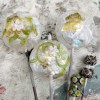Today's test is to see whether you can tell the difference between these solid dichros and the ones shown in the howto file. No? Me either. To be perfectly honest, I think this latest batch is shaped a tad better, but not so's you'd really notice. Extra points for copping the background, which really is some sort of sanding pad, such as would go on a large floor sander. No, I have no idea where it came from, since we don't have a tool it fits.
But what this post does illustrate is the physicality of making beads. Dichros require a careful touch—good control of heat, not only of the base bead, but the casing material as well. As I explained in the howto, I try to heat the dichro core to a dull cherry, while letting the molten clear cool and stiffen to the point that I can just wrap it around the core without it breaking the release; I've never found a better method for reducing the bubles that form between the dichro and the casing glass. Even so, there are always some: that white film on the horizon of the dichro is none other (see the full size image). Burning the dichro is more likely to be a problem in the shaping process, when I hit it with edge of the flame, though drippy hot casing glass will also burn the dichro. Needless to say, getting it evenly applied in the first place saves a lot of grief.
I don't make dichros on a consistant basis; maybe if I did I wouldn't have this horrid learning curve every time I make a batch. Of all the (round) beads I make on a regular basis they serve as the most sensitive test as to how in—or out—of practice I am.
Not surprisingly blue is one of the easiest colors to work with, just as red is, at least for me, unquestionably the most difficult. (And if you think about the physics of this for a moment, it makes perfect sense: red light has the shortest wavelengths, and dichro comes out of an interference effect of the metallic oxides vacuum deposited upon the glass; thus red dichro has the thinnest coat, and blue, the longest. So the only fly in this theory is why purple can be so problematic at times. It ought to be easiest. But on the whole colors on the red end of the spectrum burn up the fastest. Something to think about when you're just learning.)
file created 09apr06; minor edits to the links to the howto, 19mar14; changed dichro_solid tag to dichro, designer, 2006 on 13nov17.

Collection of pages having to do with the small, designer clear-cased dichro solid beads —the only solid beads—I regularly make. 03dec2006

Another reminder-to-self tutorial for making clear-cased solid dichros, since I keep forgetting the fine points. 09apr2006
Unless otherwise noted, text, image and objects depicted therein copyright 1996--present sylvus tarn.
Sylvus Tarn




